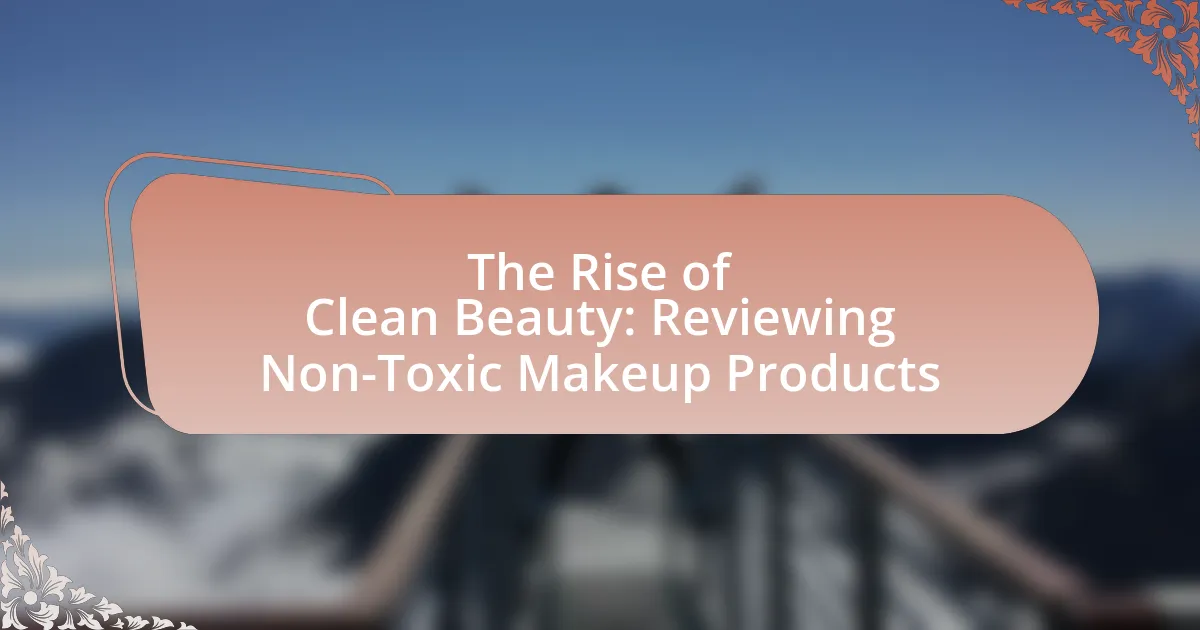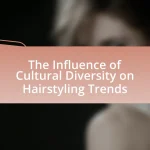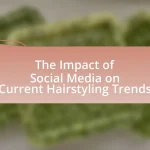Clean beauty is defined as cosmetic products formulated without harmful ingredients, emphasizing safety and environmental sustainability. This article explores the differences between clean beauty and traditional beauty products, highlighting the health risks associated with toxic chemicals commonly found in conventional cosmetics. It discusses the growing consumer demand for non-toxic makeup, driven by increased awareness of health and environmental issues, and outlines key features of non-toxic products, including ingredient transparency and certifications. Additionally, the article provides guidance on how consumers can identify harmful ingredients, evaluate clean beauty brands, and transition to a clean beauty routine, while recommending notable non-toxic makeup brands.

What is Clean Beauty and Why is it Important?
Clean beauty refers to cosmetic products formulated without harmful ingredients, prioritizing safety and environmental sustainability. This approach is important because it addresses consumer concerns about the potential health risks associated with toxic chemicals commonly found in traditional beauty products, such as parabens and phthalates. Research indicates that exposure to these substances can lead to adverse health effects, including hormonal disruptions and skin irritations. The clean beauty movement promotes transparency in ingredient sourcing and encourages brands to adopt eco-friendly practices, thereby fostering a healthier relationship between consumers and the products they use.
How does Clean Beauty differ from traditional beauty products?
Clean Beauty differs from traditional beauty products primarily in its formulation, emphasizing non-toxic, natural ingredients while avoiding harmful chemicals. Traditional beauty products often contain synthetic substances, preservatives, and potentially harmful additives, which can pose health risks and environmental concerns. For instance, Clean Beauty brands typically exclude parabens, sulfates, and phthalates, which are commonly found in conventional cosmetics and have been linked to various health issues. This shift towards Clean Beauty reflects a growing consumer demand for transparency and safety in personal care products, as evidenced by a 2021 survey indicating that 70% of consumers prefer products with clean ingredients.
What ingredients are commonly found in traditional makeup products?
Traditional makeup products commonly contain ingredients such as talc, parabens, synthetic dyes, and fragrances. Talc is often used for its absorbent properties and to provide a smooth texture, while parabens serve as preservatives to extend shelf life. Synthetic dyes are utilized for pigmentation, and fragrances are added to enhance the sensory experience of the product. These ingredients have been widely used in the cosmetics industry, but concerns regarding their safety and potential health risks have led to a growing demand for clean beauty alternatives.
What are the harmful effects of these ingredients on health and the environment?
Harmful ingredients in cosmetics can lead to various health issues and environmental damage. For instance, parabens, commonly used as preservatives, have been linked to hormone disruption and reproductive toxicity, as evidenced by research published in the Journal of Applied Toxicology, which found parabens in human breast tumors. Additionally, phthalates, often found in fragrances, are associated with endocrine disruption and developmental issues, supported by findings from the National Institute of Environmental Health Sciences. Environmentally, synthetic chemicals can contaminate water sources, harming aquatic life; a study in Environmental Science & Technology highlighted that microplastics from cosmetics contribute significantly to ocean pollution, affecting marine ecosystems.
Why has the Clean Beauty movement gained popularity?
The Clean Beauty movement has gained popularity due to increasing consumer awareness about the harmful effects of toxic ingredients in traditional beauty products. This awareness has been fueled by studies linking certain chemicals to health issues, prompting consumers to seek safer, non-toxic alternatives. For instance, a 2020 survey by the Environmental Working Group found that 70% of consumers are concerned about the safety of personal care products, leading to a significant rise in demand for clean beauty options. Additionally, social media platforms have amplified discussions around clean beauty, allowing brands that prioritize transparency and sustainability to connect with a broader audience.
What societal trends are driving the demand for non-toxic makeup?
The demand for non-toxic makeup is primarily driven by increasing consumer awareness of health and environmental issues. This trend is supported by a growing body of research indicating that many conventional cosmetics contain harmful chemicals linked to health risks, such as endocrine disruption and skin irritation. For instance, a study published in the Journal of Applied Toxicology found that certain ingredients commonly used in makeup can have adverse effects on human health. Additionally, the rise of social media has amplified the visibility of clean beauty advocates, further influencing consumer preferences towards products that are perceived as safer and more environmentally friendly. As a result, brands are responding by reformulating products to meet the demand for transparency and non-toxic ingredients, reflecting a significant shift in consumer values towards sustainability and personal health.
How do consumer awareness and education impact the Clean Beauty market?
Consumer awareness and education significantly drive the Clean Beauty market by increasing demand for non-toxic and environmentally friendly products. As consumers become more informed about harmful ingredients and their effects on health and the environment, they actively seek out brands that prioritize transparency and sustainability. For instance, a 2021 survey by the NPD Group found that 77% of consumers consider ingredient safety when purchasing beauty products, highlighting the importance of education in shaping consumer preferences. This heightened awareness leads to a shift in purchasing behavior, prompting brands to reformulate products and adopt cleaner practices to meet consumer expectations.
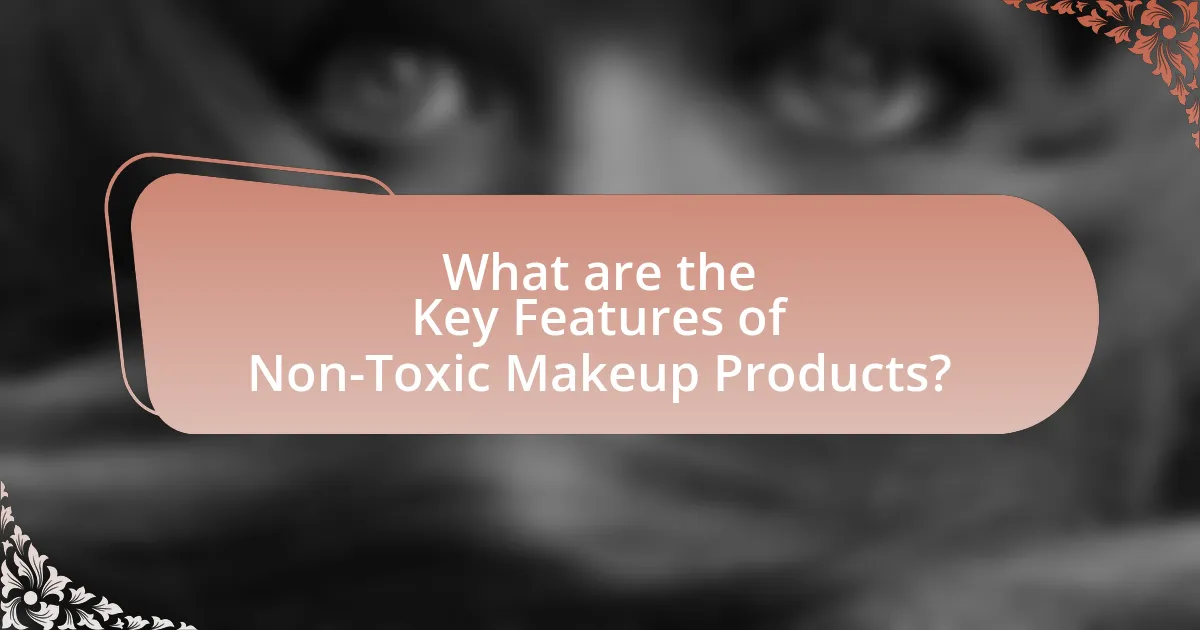
What are the Key Features of Non-Toxic Makeup Products?
Non-toxic makeup products are characterized by their use of safe, natural ingredients that do not contain harmful chemicals. These products often exclude parabens, sulfates, phthalates, and synthetic fragrances, which are commonly found in conventional cosmetics and can pose health risks. Additionally, non-toxic makeup is typically cruelty-free, meaning it is not tested on animals, and many brands prioritize eco-friendly packaging to reduce environmental impact. Research indicates that consumers are increasingly seeking products that align with their health and ethical values, driving the demand for non-toxic options in the beauty industry.
What ingredients should be avoided in non-toxic makeup?
Ingredients to avoid in non-toxic makeup include parabens, phthalates, synthetic fragrances, sulfates, and formaldehyde-releasing preservatives. Parabens are known endocrine disruptors, while phthalates can cause reproductive harm. Synthetic fragrances often contain undisclosed chemicals that may trigger allergies or sensitivities. Sulfates can irritate the skin and strip natural oils, and formaldehyde-releasing preservatives are linked to cancer risks. These ingredients are commonly found in conventional cosmetics but are excluded from non-toxic formulations to promote safer, healthier beauty products.
How can consumers identify harmful ingredients in makeup labels?
Consumers can identify harmful ingredients in makeup labels by learning to recognize specific toxic substances and understanding ingredient labeling practices. Common harmful ingredients include parabens, phthalates, sulfates, and formaldehyde-releasing agents, which are often linked to health concerns such as hormonal disruption and skin irritation. The Environmental Working Group (EWG) provides a comprehensive database that rates cosmetic ingredients based on their safety, helping consumers make informed choices. Additionally, consumers should look for certifications like “cruelty-free” and “non-toxic,” which can indicate safer formulations. By familiarizing themselves with these harmful substances and utilizing available resources, consumers can effectively navigate makeup labels for safer products.
What are the benefits of using natural and organic ingredients?
Using natural and organic ingredients offers numerous benefits, including reduced exposure to harmful chemicals, enhanced skin compatibility, and environmental sustainability. Natural and organic ingredients are less likely to cause skin irritation or allergic reactions, as they typically contain fewer synthetic additives. For instance, a study published in the Journal of Cosmetic Dermatology found that products with natural ingredients significantly reduced skin irritation compared to those with synthetic components. Additionally, organic farming practices promote biodiversity and reduce pollution, contributing to a healthier ecosystem. This aligns with consumer preferences for safer, eco-friendly products, as evidenced by a 2021 survey from Statista, which indicated that 60% of consumers prioritize natural ingredients in their beauty products.
How do non-toxic makeup products perform compared to traditional products?
Non-toxic makeup products generally perform comparably to traditional products, though performance can vary based on formulation and brand. Studies indicate that many non-toxic formulations are designed to deliver similar coverage, longevity, and finish as their traditional counterparts, often using natural ingredients that can enhance skin health. For instance, a 2020 study published in the Journal of Cosmetic Science found that non-toxic foundations provided similar wear time and coverage levels as traditional foundations, while also reducing skin irritation in users. This evidence supports the assertion that non-toxic makeup can effectively meet consumer performance expectations while prioritizing safety and health.
What are the common misconceptions about the effectiveness of non-toxic makeup?
Common misconceptions about the effectiveness of non-toxic makeup include the belief that it is less effective than conventional makeup and that it lacks longevity. Many consumers assume that non-toxic formulations do not perform as well, but studies show that advancements in clean beauty technology have led to products that match or exceed the performance of traditional cosmetics. For instance, a report by the Environmental Working Group highlights that many non-toxic brands utilize innovative ingredients that provide comparable wear time and pigmentation. Additionally, some people think that non-toxic makeup is only suitable for sensitive skin, while in reality, many formulations cater to a wide range of skin types and concerns, proving effective for diverse users.
How do consumers perceive the quality of non-toxic makeup products?
Consumers generally perceive the quality of non-toxic makeup products as high, valuing safety and health benefits over traditional options. This perception is supported by a growing awareness of harmful chemicals in cosmetics, leading to increased demand for safer alternatives. Research indicates that 70% of consumers prioritize non-toxic ingredients, associating them with better skin health and overall product efficacy. Additionally, brands that emphasize transparency in their ingredient sourcing and formulation processes tend to receive higher trust and satisfaction ratings from consumers.
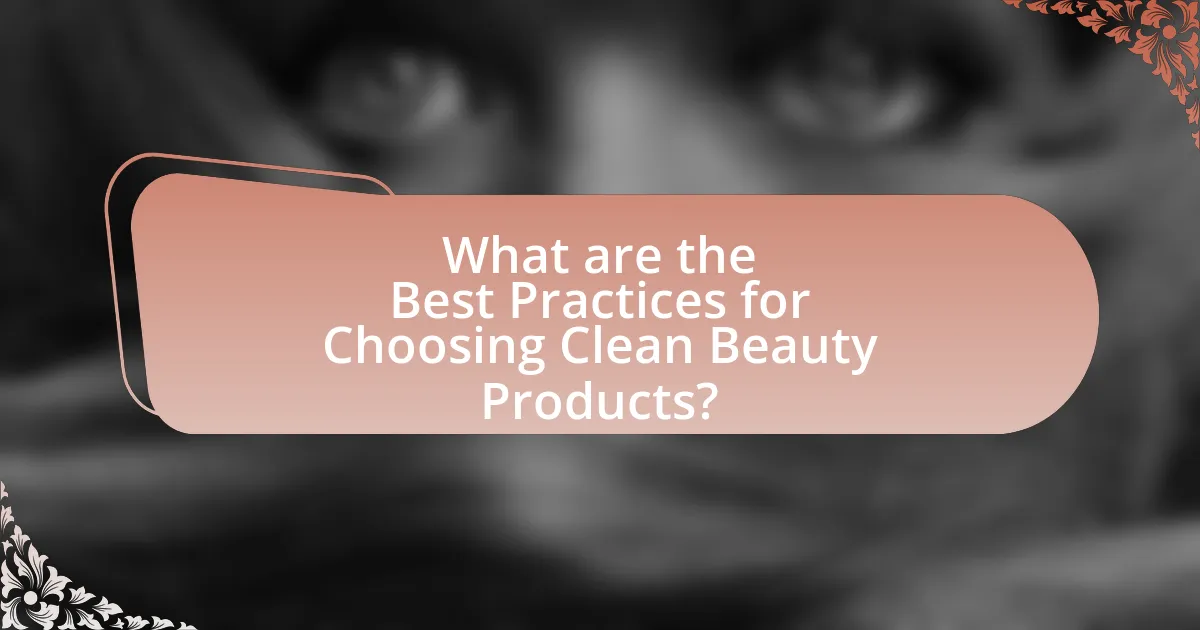
What are the Best Practices for Choosing Clean Beauty Products?
To choose clean beauty products effectively, prioritize products with transparent ingredient lists and certifications from reputable organizations. Transparency in labeling allows consumers to identify harmful chemicals and allergens, while certifications, such as USDA Organic or EWG Verified, indicate adherence to safety and environmental standards. Research shows that many conventional beauty products contain potentially harmful substances, such as parabens and phthalates, which can disrupt hormonal balance and pose health risks. Therefore, selecting products that are free from these ingredients is essential for maintaining health and wellness.
How can consumers evaluate Clean Beauty brands?
Consumers can evaluate Clean Beauty brands by examining ingredient transparency, certifications, and brand practices. Ingredient transparency involves checking for clear labeling of all components, ensuring that harmful substances are excluded, such as parabens and sulfates. Certifications from reputable organizations, like the Environmental Working Group or Leaping Bunny, provide assurance that products meet specific safety and ethical standards. Additionally, consumers should consider the brand’s commitment to sustainability and ethical sourcing, as these factors reflect the overall integrity of the brand. Research indicates that 70% of consumers prioritize ingredient safety when choosing beauty products, highlighting the importance of informed evaluation.
What certifications should consumers look for in Clean Beauty products?
Consumers should look for certifications such as USDA Organic, Ecocert, and Leaping Bunny in Clean Beauty products. These certifications indicate that the products meet specific standards for organic ingredients, environmentally friendly practices, and cruelty-free testing, respectively. For instance, USDA Organic certification ensures that at least 95% of the product’s ingredients are organic, while Ecocert verifies that products adhere to strict environmental and social criteria. Leaping Bunny certification confirms that no animal testing was conducted at any stage of product development, providing assurance to consumers concerned about ethical practices.
How can ingredient transparency influence brand trustworthiness?
Ingredient transparency significantly enhances brand trustworthiness by allowing consumers to make informed choices about the products they use. When brands disclose detailed information about their ingredients, it fosters a sense of honesty and accountability, which are critical components of trust. Research indicates that 73% of consumers are more likely to purchase from brands that provide clear ingredient information, as this transparency aligns with their values of health and safety. Furthermore, brands that openly share their ingredient sourcing and formulation processes are perceived as more credible, leading to increased customer loyalty and positive brand perception.
What tips can help consumers transition to a Clean Beauty routine?
To transition to a Clean Beauty routine, consumers should start by researching and understanding the ingredients in their current products. This knowledge allows consumers to identify harmful chemicals commonly found in conventional beauty products, such as parabens and sulfates, which can have negative health effects. Gradually replacing these products with clean alternatives that are free from toxic ingredients is essential; for instance, choosing brands that are certified organic or have transparent ingredient lists. Additionally, consumers can benefit from patch testing new products to ensure compatibility with their skin, as clean products can still cause reactions. According to a study published in the Journal of Cosmetic Dermatology, consumers who switch to clean beauty products report fewer skin irritations and improved overall skin health.
How can consumers gradually replace their traditional makeup with non-toxic alternatives?
Consumers can gradually replace their traditional makeup with non-toxic alternatives by starting with one product category at a time, such as foundation or lipstick. This approach allows consumers to assess the effectiveness and compatibility of non-toxic products with their skin while minimizing the risk of overwhelming changes. Research indicates that the clean beauty market is growing, with a 2021 report by Grand View Research showing a projected compound annual growth rate of 9.7% from 2021 to 2028, highlighting increasing consumer demand for safer cosmetics. By prioritizing brands that are transparent about their ingredients and certifications, consumers can make informed choices that align with their health and environmental values.
What are some recommended non-toxic makeup brands to consider?
Some recommended non-toxic makeup brands to consider include RMS Beauty, Ilia Beauty, and 100% Pure. RMS Beauty is known for its organic ingredients and commitment to sustainability, while Ilia Beauty combines skincare benefits with makeup, using clean formulations. 100% Pure emphasizes the use of fruit pigments and natural ingredients, ensuring their products are free from harmful chemicals. These brands have gained recognition for their transparency and dedication to non-toxic beauty, aligning with the growing demand for clean beauty products.
